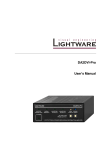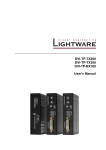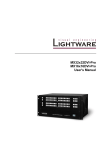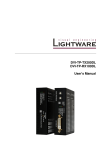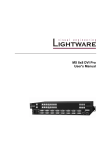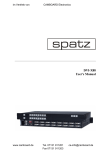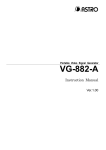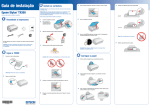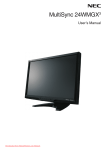Download DVI-OPT-TX200 DVI-OPT-RX200 User`s Manual
Transcript
DVI-OPT-TX200 DVI-OPT-RX200 User's Manual Page 2 / 39 DVI-OPT-TX200/RX200 User’s Manual Rev. 1.0 SAFETY INSTRUCTIONS Class I apparatus construction. This equipment must be used with a main power system with a protective earth connection. The third (earth) pin is a safety feature, do not bypass or disable it. This equipment should be operated only from the power source indicated on the product. To disconnect the equipment safely from power, remove the power cord from the rear of the equipment, or from the power source. The MAINS plug is used as the disconnect device, the disconnect device shall remain readily operable. There are no user-serviceable parts inside of the unit. Removal of the top cover will expose dangerous voltages. To avoid personal injury, do not remove the top cover. Do not operate the unit without the cover installed. The apparatus shall not be exposed to dripping or splashing and that no objects filled with liquids, such as vases, shall be placed on the apparatus. The apparatus must be safely connected to multimedia systems. Follow instructions described in this manual. Replacing the AC f use Unplug the AC power cord from the equipment Locate the AC fuse on the rear of the unit Replace only the AC fuse as indicated on the rear panel of the unit: 3.15A fast blowing Connect the power cord to the switcher and to the AC power source. Make sure the switcher is working properly. WEEE ( W as te E l e c tr ic a l & E lec tr on ic Eq u ipm en t) Co rr e ct Di sp o s al o f T h is P ro d u ct This marking shown on the product or its literature, indicates that it should not be disposed with other household wastes at the end of its working life. To prevent possible harm to the enviroment or human health from uncontrolled waste disposal, please separate this from other types of wastes and recycle it responsibily to promote the sustainable reuse of material resources. Household users should contact either the retailer where they purchased this product, or their local government office, for details of where and how they can take this item for environmentally safe recycling. Business users should contact their supplier and check the terms and conditions of the purchase contract. This product should not be mixed with other commercial wastes for disposal. Page 3 / 39 DECLARATION OF CONFORMITY We, Lightware Kft. 1071 Budapest Peterdy str. 15 HUNGARY as manufacturer declare, that the products product DVI-OPT-TX200 DVI-OPT-RX200 ( Computer Monitor Extender ) in accordance with the EMC Directive 2004/108/EC and the Low Voltage Directive 2006/95/EEC is in conformity with the following standards: EMI/EMC ...................... EN 55103-1 E3, EN 55103-2 Safety............................................. ................................ EN 60065 Class I Date: 01 December 2009 Name: Gergely Vida ( Managing Director ) Signed: Page 4 / 39 DVI-OPT-TX200/RX200 User’s Manual Rev. 1.0 Table of contents 1. INTRODUCTION .............................................................................................................................7 2. GENERAL DESCRIPTION..............................................................................................................7 2.1. BOX CONTENTS .........................................................................................................................7 2.2. TRANSMITTER FEATURES (DVI-OPT-TX200) .............................................................................7 2.3. RECEIVER FEATURES (DVI-OPT-RX200) ..................................................................................8 2.4. UNDERSTANDING EDID .............................................................................................................9 2.4.1. Basics .............................................................................................................................9 2.4.2. Common problems related to EDID ...............................................................................9 2.5. ADVANCED EDID MANAGEMENT (DVI-OPT-TX200) ............................................................... 10 2.6. SINGLE FIBER TECHNOLOGY ................................................................................................... 10 2.7. APPLICATIONS ........................................................................................................................ 11 2.7.1. Stand-alone ................................................................................................................. 11 2.7.2. Break-out ..................................................................................................................... 11 2.7.3. Using with Lightware Hybrid routers ........................................................................... 12 2.8. FRONT AND REAR VIEW ........................................................................................................... 13 2.8.1. Front view of DVI-OPT-TX200 .................................................................................... 13 2.8.2. Rear view of DVI-OPT-TX200 ..................................................................................... 14 2.8.3. Front view of DVI-OPT-RX200 .................................................................................... 15 2.8.4. Rear view of DVI-OPT-RX200 .................................................................................... 15 2.9. ELECTRICAL CONNECTIONS ..................................................................................................... 16 2.9.1. DVI inputs and outputs ................................................................................................ 16 2.9.2. RS-232 control port ..................................................................................................... 16 3. OPERATION OF DVI-OPT-TX200 ............................................................................................... 17 3.1. 3.2. 3.3. 3.4. 3.5. 4. OPERATION OF DVI-OPT-RX200 .............................................................................................. 20 4.1. 4.2. 4.3. 5. POWER .................................................................................................................................. 17 MENU STRUCTURE ................................................................................................................. 17 SWITCHING THE EDID ............................................................................................................ 18 FACTORY PRESET EDID LIST .................................................................................................. 19 LEARNING THE EDID .............................................................................................................. 19 POWER .................................................................................................................................. 20 FRONT PANEL INDICATORS ...................................................................................................... 20 REAR PANEL ALARM OUTPUTS ................................................................................................. 20 SOFTWARE CONTROL – USING LIGHTWARE MATRIX CONTROLLER ............................... 21 5.1. ESTABLISHING THE CONNECTION ............................................................................................. 21 5.2. EDID MENU ........................................................................................................................... 22 5.2.1. EDID Router operation ................................................................................................ 22 5.2.2. Advanced EDID Editor ................................................................................................ 25 5.3. TERMINAL MENU ..................................................................................................................... 25 5.4. STATUS MENU ...................................................................................................................... 26 5.5. FIND MENU ............................................................................................................................. 26 5.6. CONTROL COMMANDS............................................................................................................. 27 5.6.1. View product type ........................................................................................................ 27 5.6.2. View serial number ...................................................................................................... 27 5.6.3. View firmware version ................................................................................................. 27 5.6.4. Route EDID to the input (static) .................................................................................. 27 5.6.5. Route EDID to the input (dynamic) ............................................................................. 28 5.6.6. Save EDID from output to memory location (Learn EDID) ......................................... 28 5.6.7. View EDID validity table .............................................................................................. 29 5.6.8. View EDID header ....................................................................................................... 29 5.6.9. Download EDID content from the DVI-OPT-TX200 .................................................... 29 5.6.10. Upload EDID content to the DVI-OPT-TX200 ............................................................. 30 Page 5 / 39 5.7. DVI-OPT-TX200 INITIATED COMMANDS .................................................................................. 31 5.7.1. EDID status changed ................................................................................................... 31 5.7.2. Error responses ........................................................................................................... 31 6. TROUBLESHOOTING ................................................................................................................. 32 6.1. 7. THERE IS NO PICTURE ON RECEIVER DVI OUTPUT ..................................................................... 32 MECHANICAL DRAWINGS ......................................................................................................... 34 7.1. DVI-OPT-TX200 ................................................................................................................... 34 7.1.1. Front view .................................................................................................................... 34 7.1.2. Rear view ..................................................................................................................... 34 7.1.3. Bottom view ................................................................................................................. 34 7.2. DVI-OPT-RX200 ................................................................................................................... 35 7.2.1. Front view .................................................................................................................... 35 7.2.2. Rear view ..................................................................................................................... 35 7.2.3. Bottom view ................................................................................................................. 35 8. WARRANTY ................................................................................................................................. 36 9. SPECIFICATIONS ........................................................................................................................ 37 Page 6 / 39 DVI-OPT-TX200/RX200 User’s Manual Rev. 1.0 1. Introduction Dear Customer, Thank you for choosing Lightware DVI-OPT series transmitters and receivers. DVI-OPT-TX200 and DVI-OPT-RX200 are Single Link DVI over fiber optical cable extenders which allow video signals of up to 1920x1200@60 Hz resolution to be transmitted through 2600 meters of OM3e type fiber optical cables. 2. General description 2.1. 2.2. Box contents − DVI-OPT-TX200 or − DVI-OPT-RX200 − User's Manual − Quick Start Guide − IEC Power Cable Transmitter features (DVI-OPT-TX200) Galvanic Isolation between source and display – Lightware fiber optical extenders are isolated between transmitter and receiver to eliminate ground loop noise or HUM effects. Advanced EDID Management – The user can emulate any EDID on the DVIOPT-TX200’s input, read out and store any monitor's EDID (attached to Local Monitor Output) in 50 internal memory locations. Supports all HDTV resolutions – 720p, 1080i, 1080p etc. without HDCP encoding. Unencrypted signals up to 165 MHz pixel clock frequency - regardless of the resolution - are passed through. Single Fiber Technology – All of the high-speed TMDS data lanes are transmitted using only one multimode 50/125 fiber optical cable. Local Monitor Output – Users can attach a local monitor to observe the video signal sent through the fiber optical cable. The resolution and clock frequency are the same on DVI and fiber optical connectors, no internal scaling or conversion is applied. Break-out LC connector – A break-out LC fiber optical connector allows users to transmit the signal of two transmitters in one Neutrik opticalCON DUO cable. For typical application, see chapter 2.7. Front panel control – EDID address selection, EDID learning, firmware versions, laser enable/disable functions are available on LCD based menu with navigation buttons. Software control – Input status, EDID Management, Terminal Window and hardware information can be accessed in Lightware Matrix Controller software via RS-232 serial connection. Built-in universal power supply – DVI-OPT-TX200 is equipped with a built-in universal power supply, which accepts AC voltages from 100 to 240 Volts with 50 or 60 Hz line frequency. Page 7 / 39 2.3. Page 8 / 39 Receiver features (DVI-OPT-RX200) Supports all HDTV resolutions – 720p, 1080i, 1080p etc. without HDCP encoding. Unencrypted signals up to 165 MHz pixel clock frequency - regardless of the resolution - are passed through. Single Fiber Technology – All of the high-speed TMDS data lanes are transmitted using only one multimode 50/125 fiber optical cable. Two identical DVI outputs – A built-in distribution amplifier transmits the signal coming from fiber B of the Neutrik connector to two DVI output connectors. Laser Detected LED – Bi-color (green and red) LED indicates when a laser beam is detected on input B of the Neutrik connector. DVI Signal Present and Monitor Connected LEDs – Three LEDs indicate when a valid DVI signal is detected and when display devices are connected and they are sending Hot Plug signals. Alarm outputs – Two TTL level alarm outputs are provided for DVI signal detection and laser detection. A ground reference signal is also provided. Break-out LC connector – A break-out LC fiber optical connector allows the users to receive the signal of two optical transmitters in one Neutrik opticalCON DUO cable, that has two fiber cores. For typical application, see chapter 2.7. Built-in universal power supply – DVI-OPT-TX200 is equipped with a built-in universal power supply, which accepts AC voltages from 100 to 240 Volts with 50 or 60 Hz line frequency. DVI-OPT-TX200/RX200 User’s Manual Rev. 1.0 2.4. Understanding EDID 2.4.1. Basics EDID stands for Extended Display Identification Data. Simply put, EDID is the passport of display devices (monitors, TV sets, projectors). It contains information about the display’s capabilities, such as supported resolutions, refresh rates (these are called Detailed Timings), the type and manufacturer of the display device, etc. After connecting a DVI source to a DVI display, the source reads out the EDID to determine the resolution and refresh rate of the image to be transmitted. Most DVI computer displays have 128-byte long EDID structure. However, Digital Televisions and HDMI capable displays may have another 128 bytes, which is called E-EDID and defined by CEA (Consumer Electronics Association). This extension contains information about additional Detailed Timings, audio capabilities, speaker allocation and HDMI capabilities. It is important to know, that all HDMI capable devices must have CEA extension, but not all devices are HDMI capable which have the extension. 2.4.2. Common problems related to EDID Problem: „My system consists of the following: a PC, then a Lightware DVI-OPTTX200, a WUXGA (1920x1200) LCD as local monitor, then a DVI-OPTRX200 connected to a SXGA (1280x1024) projector. I would like to see the same image on the monitor and the projector. What EDID should I chose on the DVI-OPT-TX200?” (see typical application in chapter 2.7) Solution: If you want to see the image on both displays, you need to select the resolution of the smaller display (in this case SXGA), otherwise the smaller display may not show the higher resolution image. Page 9 / 39 Problem: „I emulated a different EDID on the front panel of the DVI-OPT-TX200 to have a different resolution but nothing happens.” Solution: Some graphics cards and video sources read out the EDID only after power-up and later they don’t sense that EDID has been changed. You need to restart your source to make it read out the EDID again. Problem: „I have a DVI-OPT-TX200 and I’m using a Lightware factory preset EDID. I would like to be able to choose from different resolutions, but my source allows only one resolution.” Solution: 2.5. Most Lightware factory preset EDID allow only one resolution, forcing the sources to output only that particular signal. You need to select the Universal EDID (address 49). It supports all common VESA resolutions. Additionally it also features audio support. Advanced EDID Management (DVI-OPT-TX200) Each DVI sink (e.g. monitors, projectors, plasma displays, and switcher inputs) must support the EDID data structure. Source BIOS and operating systems are likely to query the sink using DDC2B protocol to determine what pixel formats and interface are supported. DVI standard makes use of EDID data structure for the identification of the monitor type and capabilities. Most DVI sources (VGA cards, set top boxes, etc) will output DVI signal after accepting the connected sink’s EDID information. In case of EDID readout failure or missing EDID the source will not output DVI video signal. DVI-OPT-TX200 provides Lightware’s Advanced EDID Management function that helps system integration. It stores and emulates 99 EDID plus the EDID of the display device which is connected to LOCAL MONITOR OUTPUT. Memory addresses from 01 to 50 are factory presets, while memories from 51 to 99 are user programmable. DVI-OPT-TX200 stores the EDID of the monitor or projector connected to LOCAL MONITOR OUTPUT in a non-volatile memory. The EDID emulated on the input can be copied from the DVI-OPT-TX200's memory (static EDID emulation) or from the attached monitor (dynamic EDID emulation). For example, the DVI-OPT-TX200 can be set up to emulate the device, which is connected to LOCAL MONITOR OUTPUT, and the EDID automatically changes, if the monitor is replaced with another display device (as long as it has a valid EDID). Info The user is not required to disconnect the DVI cable to change an EDID as opposed to other manufacturer’s products. EDID can be changed even if source is connected to the input and powered ON. 2.6. Single Fiber Technology DVI-OPT-TX200 and DVI-OPT-RX200 transmit the video signal using only one multimode 50/125 fiber optical cable instead of four, like many other applications. This technology reduces cable cost and installation difficulties. A full HD 1080p signal can be transmitted through 2600 meters of OM3e type fiber optical cable. Each Neutrik NO2-4FDW type LC duplex connector has two available LC connections. The user can either connect a single core multimode 50/125 fiber optical cable with an LC type connector or a Neutrik opticalCON DUO field cable having two multimode 50/125 fiber cores. Page 10 / 39 DVI-OPT-TX200/RX200 User’s Manual Rev. 1.0 2.7. Applications 2.7.1. Stand-alone Typical stand-alone application 2.7.2. Break-out Neutrik opticalCON DUO cables provide two fiber cores inside one cable assembly. DVI-OPT-TX200 and RX200 are equipped with break-out LC connectors, making it possible to connect two DVI-OPT-TX200s and RX200s using only one opticalCON DUO cable. The break-out LC connectors are internally connected to the Neutrik NO2-4FDW type LC duplex connectors with fiber optical patch cables. The following application diagram shows how the units must be connected. The labels on the rear panel of the units show the connection of the internal fiber optical cables. Break-out application Page 11 / 39 2.7.3. Using with Lightware Hybrid routers Using with Lightware MX32x32 FR32R frame (the frame is equipped with MX-DVI-OPT fiber optical cards) Page 12 / 39 DVI-OPT-TX200/RX200 User’s Manual Rev. 1.0 2.8. Front and rear view 2.8.1. Front view of DVI-OPT-TX200 LCD Power LED Status LEDs Navigation buttons Power LED Green LED indicates if the device is powered on. It does not indicate whether the device is operating properly. LCD Intuitive 2x16 character LCD based menu system allows for fast and easy operation of EDID Management. The four direction navigation buttons toggle between menu items Laser Active LED Green LED indicates when the laser driver is enabled to help avoid accidentally looking into the laser beam. DVI Signal Present LED Green LED indicates when a valid DVI signal is detected on the DVI INPUT connector. Source Connected LED Indicates if a DVI source is connected to the DVI-OPTTX200, it is powered on and sends +5V signal to Pin 14 of the input DVI connector. Navigation buttons Four direction buttons and ENTER button are provided for easy navigation between menu items. Left (◄) and right (►) buttons toggle between menu items, up (▲) and down (▼) buttons modify settings after entering a menu item. Page 13 / 39 2.8.2. Rear view of DVI-OPT-TX200 AC power connector DVI INPUT RS-232 port Laser active LED Break-out LC connector Local Monitor Output Neutrik connector AC power connector Standard IEC power connector. DVI-OPT-TX200 works with 100 to 240 Volts, 50 or 60 Hz power sources. RS-232 port 9-pole D-SUB communication. DVI INPUT Connect one single link DVI-D or DVI-I cable (only digital pins are connected internally) between the DVI source and DVI-OPT-TX200. The unit has minimal cable compensation ability, hence the maximum recommended cable length – in compliance with the DVI standard – is 5 m. Local Monitor Output Connect one single link DVI-D or DVI-I cable (only digital pins are connected internally) between DVI-OPT-TX200 and local display device to monitor the outgoing signal. The resolution and pixel clock frequency are the same on the DVI and Neutrik connectors, no internal scaling or conversion is applied to the signal. Laser Active LED Green LED indicates when the laser driver is enabled to help avoid accidentally looking into the laser beam. Break-out LC connector The break-out LC connector is internally connected to output B of the Neutrik connector with a multimode 50/125 fiber optical patch cable. The user can connect the signal of another fiber optical transmitter to pass it through a doublecore Neutrik fiber optical cable. For typical application, see chapter 2.7. Neutrik connector Neutrik NO2-4FDW type LC duplex connector. Transmitting the signals of up to two transmitters is available (one from the break-out LC connector). The four copper pins of the connector are not connected internally. Page 14 / 39 female connector for serial RS-232 DVI-OPT-TX200/RX200 User’s Manual Rev. 1.0 2.8.3. Front view of DVI-OPT-RX200 Power LED Status LEDs Power LED Green LED indicates if the device is powered on. It does not indicate whether the device is operating properly. Laser Detected LED Bi-color (red and green) LED indicates if a laser beam is detected. If the LED is illuminated green, then a laser beam is detected. If the LED is flashing red, then no laser beam is detected. DVI Signal Present LED Green LED indicates if a valid DVI clock signal can be recovered from the fiber optical signal. Monitor Hotplug LEDs Green LEDs indicate if display devices (or repeaters, etc.) are connected to the DVI OUT1-2 connectors and they send a valid Hot Plug Signal on Pin 16 through the DVI cables. 2.8.4. Rear view of DVI-OPT-RX200 Break-out LC connector AC power connector Neutrik connector Alarm outputs DVI output 1 DVI output 2 AC power connector Standard IEC power connector. DVI-OPT-RX200 works with 100 to 240 Volts, 50 or 60 Hz power sources. Break-out LC connector The break-out LC connector is internally connected to input A of the Neutrik connector with a multimode 50/125 fiber optical patch cable. The user can connect this connector to the input of another fiber optical receiver when two signals are sent through a double-core Neutrik fiber optical cable. For typical application, see chapter 2.7. Neutrik connector Neutrik NO2-4FDW type LC duplex connector. Receiving the signals of up to two transmitters is available (one from the break-out LC connector). The four copper pins of the connector are not connected internally. DVI OUT 1-2 Connect one single link DVI-D or DVI-I cable (only digital pins are connected internally) between DVI-OPT-RX200 and display devices. The resolution and pixel clock frequency are the same on the two DVI connectors, no internal scaling or conversion is applied to the signal. Alarm outputs DVI signal detection and laser detection signals with ground reference are available on a three-pole Phoenix connector. Page 15 / 39 2.9. Electrical connections 2.9.1. DVI inputs and outputs DVI-OPT-TX200 and DVI-OPT-RX200 provide 29 pole „digital only” DVI-I connectors for input and output connections. Always use high quality DVI cable for connecting sources and displays. Pin Signal Pin Signal Pin Signal 1 TMDS Data2- 11 TMDS D1/3 Shield 21 TMDS Data5+ (nc) 2 TMDS Data2+ 12 TMDS Data3- (nc) 22 TMDS Clk Shield 3 TMDS D2/4 Shield 13 TMDS Data3+ (nc) 23 TMDS Clock+ 4 TMDS Data4- (nc) 14 +5V Power 24 TMDS Clock- 5 TMDS Data4+ (nc) 15 GND (for +5V) 25 R (not connected) 6 DDC Clock 16 Hot Plug Detect 26 G (not connected) 7 DDC Data 17 TMDS Data0- 27 B (not connected) 8 VSYNC (nc) 18 TMDS Data0+ 28 HSYNC (nc) 9 TMDS Data1- 19 TMDS D0/5 Shield 29 Analog GND 10 TMDS Data1+ 20 TMDS Data5- (nc) Table 1. Dual link DVI-I “digital only” connector pin assignment 2.9.2. RS-232 control port DVI-OPT-TX200 can be remote controlled through industry standard 9-pole sub-D female connector located on the rear panel of the unit. RS-232 connector pin locations Pin Signal 1 Not connected 2 TX Data Transmit 3 RX Data Receive 4 DTR internally connected to Pin 6 5 GND signal ground (shield) 6 DSR internally connected to Pin 4 7 RTS internally connected to Pin 8 8 CTS internally connected to Pin 7 9 Not connected Table 2. RS-232 connector pin assignment Page 16 / 39 DVI-OPT-TX200/RX200 User’s Manual Rev. 1.0 3. Operation of DVI-OPT-TX200 3.1. Power When building an electronic system, make sure that all of the devices are powered down before connecting them. Powered on devices may have dangerous voltage levels that can damage sensitive electronic circuits. After the system is complete, connect the IEC power cable to the DVI-OPT-TX200 and then to the power outlet. The unit is immediately powered ON. The front panel LCD will first show the unit’s firmware versions, then after a few seconds, it will show which EDID is emulated on the DVI INPUT connector. At this point the DVI-OPT-TX200 is fully initialized and ready to use. After the DVI-OPT-TX200 is initialized, the attached DVI source and monitor can be powered on. Info If none of the LEDs nor the LCD light up upon power-up, the unit is most likely damaged and further use is not advised. Please contact [email protected] 3.2. Menu structure The front panel LCD has 2 lines and 16 characters in each line. The name of the menu item is always shown in the first line. The left (◄) and right (►) navigation buttons can be used to toggle between menu items. The up (▲) and down (▼) buttons modify the settings in each menu item. FIRMWARE VERSIONS DVI-OPT-TX200 FW: 1 . 2 . 1 HW: 1 . 2 The name and the firmware versions of the device. Emulated EDID EMULATED EDID 49 [email protected] Emulated EDID 49 UniversalEDID Emulated EDID The currently emulated EDID. Three screens toggle automatically showing the preferred resolution, the name of the display and a three letter abbreviation assigned to the manufacturer. Lightware factory presets have LWR as the manufacturer. 49 LWR Learn EDID 51 [email protected] Learn EDID 51 LCD1970NXp Learn EDID 51 LEARN EDID Select a memory address using the up (▲) and down (▼) buttons, then press ENTER to store the EDID in the selected slot. If a filled slot is selected, then the ENTER button will overwrite the previously stored EDID. Three screens toggle automatically showing the preferred resolution, the name of the display and a three letter abbreviation assigned to the manufacturer. NEC Page 17 / 39 Attached Monitor ATTACHED MONITOR [email protected] Shows information about the attached monitor. If no monitor is connected, then the last attached monitor’s information is displayed. Three screens toggle automatically showing the preferred resolution, the name of the display and a three letter abbreviation assigned to the manufacturer. Attached Monitor 24WMGX3 Attached Monitor NEC Switch EDID 33 [email protected] Switch EDID 33 1440x576i@50 Switch EDID 33 SWITCH EDID Use the up (▲) and down (▼) buttons to select a filled memory slot, then press ENTER to emulate the EDID. Hold down the up (▲) and down (▼) buttons to scroll faster. Three screens toggle automatically showing the preferred resolution, the name of the display and a three letter abbreviation assigned to the manufacturer. Lightware factory presets have LWR as the manufacturer. LWR FACTORY RESET Factory Reset OK 3.3. Info Page 18 / 39 Press the ENTER button to reset the device to the factory preset values. Switching the EDID 1. Use the left (◄) and right (►) buttons to select the SWITCH EDID menu item and the up (▲) and down (▼) buttons to select the desired EDID. 2. The address 00 (zero zero) has a special function. If a monitor is connected to LOCAL MONITOR OUT, then its EDID is copied to the DVI INPUT connector. If no monitor is connected to the output then the EDID transmitted to the DVI INPUT connector is the EDID of the last connected monitor. After every EDID change, DVI-OPT-TX200 toggles the HOT PLUG signal for approx. 1 sec. Some graphic cards or DVD players do not sense the HOT PLUG signal, and even if EDID has been changed, the set resolution is not affected. In this case the source device must be restarted, or powered OFF and ON again. DVI-OPT-TX200/RX200 User’s Manual Rev. 1.0 3.4. Factory preset EDID list Lightware factory pre-loaded EDIDs are specially provided to force graphic cards to output only the exact pixel resolution and refresh rate. Universal EDID (address 49) allows multiple resolutions including all common VESA defined resolutions. In addition, it also features audio support. The use of universal EDID is recommended for fast and easy system setup. MEMORY Resolution MEMORY Resolution 01 640x480@60 Hz 26 1600x1200@50 Hz 02 640x480@75 Hz 27 1600x1200@60 Hz 03 848x480@60 Hz 16:9 28 1920x1200@60 Hz 04 800x600@50 Hz 29 1920x1200@50 Hz 05 800x600@60 Hz 30 [email protected] Hz 06 07 800x600@75 Hz 1024x768@50 Hz 31 32 [email protected] Hz 720x480p@60 Hz 08 1024x768@60 Hz 33 576i@50 Hz 09 1024x768@75 Hz 34 720x576p@50 Hz 10 1152x864@75 Hz 35 1280x720p@50 Hz 11 1280x768@50 Hz 36 1280x720p@60 Hz 12 13 1280x768@60 Hz 1280x768@75 Hz 37 38 1920x1080i1 @50 Hz 1920x1080i2 @50 Hz 14 1360x768@60 Hz 39 1920x1080i@60 Hz 15 1364x768@50 Hz 40 1920x1080p@24 Hz 16 1364x768@60 Hz 41 1920x1080p@25 Hz 17 1364x768@75 Hz 42 1920x1080p@30 Hz 18 19 1280x1024@50 Hz 1280x1024@60 Hz 43 44 1920x1080p1 @50 Hz 1920x1080p2 @50 Hz 20 1280x1024@75 Hz 45 1920x1080p@60 Hz 21 1366x1024@60 Hz 46 2048x1080p1 @50 Hz 22 1400x1050@50 Hz 47 2048x1080p2 @50 Hz 23 1400x1050@60 Hz 48 2048x1080p@60 Hz 24 25 1400x1050@75 Hz 1680x1050@50 Hz 49 50 UNIVERSAL EDID 2560x1600@60 Hz Table 3. Factory Preset EDID list 3.5. Learning the EDID The factory preset EDIDs cannot be changed by the user. Only addresses from 51 to 99 are user programmable. 1. After connecting the sink device to LOCAL MONITOR OUT, use the left (◄) and right (►) buttons to select the LEARN EDID menu item and the up (▲) and down (▼) buttons to select an empty memory address. Hold down the up (▲) and down (▼) buttons to scroll faster. If the second line of the LCD shows a – (minus) sign, then the memory slot is empty and ready to be programmed. If the line shows EDID data, then the memory was already used before, but still available for programming. 2. Info Push the ENTER button to store the EDID. EDIDs are stored in a multiple programmable non-volatile memory. Page 19 / 39 4. Operation of DVI-OPT-RX200 4.1. Power When building an electronic system, make sure that all of the devices are powered down before connecting them. Powered on devices may have dangerous voltage levels that can damage sensitive electronic circuits. After the system is complete, connect the IEC power cable to the DVI-OPT-RX200 and then to the power outlet. The unit is immediately powered ON. The DVI-OPT-RX200 does not have any firmware, the unit is completely hardware based. Therefore no firmware version will be indicated upon power-up and there is no need for firmware upgrades. After the DVI-OPT-RX200 is initialized, the attached DVI source and monitor can be powered on. Info If none of the LEDs nor the LCD light up upon power-up, the unit is most likely damaged and further use is not advised. Please contact [email protected] 4.2. Front panel indicators The DVI-OPT-RX200 provides five front panel LEDs which indicate the following: Power Indicates if the device is powered on. It does not indicate whether the device is operating properly. Green: Laser Detected Bi-color (red and green) LED indicates if a laser beam is detected. If the LED is illuminated green, then a laser beam is detected. If the LED is flashing red, then no laser beam is detected. DVI Signal Present Green LED indicates if a valid DVI clock signal can be recovered from the fiber optical signal. Monitor 1-2 Hotplug Green LED indicates if display devices (or matrix switchers, repeaters, etc.) are connected to DVI OUT1-2 connectors and they are sending a valid Hot Plug Signal on Pin 16 through the DVI cables. 4.3. Rear panel alarm outputs DVI-OPT-RX200 provides two TTL level alarm outputs which indicate the following: Page 20 / 39 DVI Detect Indicates when a valid DVI clock signal is extracted from the fiber optical signal. Logic 1 (+5V) means that a DVI signal is detected. Logic 0 (GND) means that a valid DVI signal cannot be extracted from the optical signal. Laser Detect Indicates when a laser beam is detected at the Neutrik connector. Logic 1 (+5V) means that a laser beam with the appropriate wavelength is detected. Logic 0 (GND) means that either there is no laser signal or its level is too low to be recognised. GND Ground reference signal for alarm outputs. DVI-OPT-TX200/RX200 User’s Manual Rev. 1.0 Output logic diagram of the TTL alarm outputs: 5V 330 Ω Alarm output GND 5. Software Control – Using Lightware Matrix Controller 5.1. Establishing the connection DVI-OPT-TX200 can be controlled using Lightware Matrix Controller software from a PC or Laptop via RS-232 port. 1. Connect a serial cable between the PC and the DVI-TX200. 2. To run the CONTROL SOFTWARE, double click on the icon of the software on the desktop or select the proper shortcut from Start Menu/ Programs/ Lightware folder. 3. Select the appropriate COM port and click on Connect. Page 21 / 39 4. After clicking on the Connect button, the Lightware Matrix Controller finds the hardware, recognizes the product type, and a button matrix area (crosspoint area) appears according to the input and output numbers of the device. For DVI-OPT-TX200, I1 column represents the input, O1 row represents the output. Regardless of the fact that a crosspoint switching area appears, the input signal is always routed to the output by default. Crosspoint area Info The connect process may take up to 10 seconds. 5.2. EDID menu 5.2.1. EDID Router operation By clicking on the EDID menu, the EDID router window appears. When the user enters the menu for the first time, the software starts to download the whole EDID content from the DVI-OPT-TX200. It may take about 10 seconds. After the list is downloaded, the current status of the EDID list is shown in two windows (list window areas). In the drop-down menus above the two windows you can select which part of the EDID memory you want to see. The Emulated EDID List window contains the resolution, manufacturer and vendor name of the EDID emulated or reported to the source. The source column displays the memory location that the current EDID was routed from. The Last attached Monitor's EDID List window contains the resolution, manufacturer and vendor name of the display device connected to LOCAL MONITOR OUTPUT. The Factory EDID List window shows the fifty factory preprogrammed EDID. The User EDID List shows the memory locations which can be used by the user to save EDID. Page 22 / 39 DVI-OPT-TX200/RX200 User’s Manual Rev. 1.0 List window areas Change emulated EDID at the input – Drag and Drop The two main types of the emulation are the static and the dynamic: Static EDID emulation: when an EDID from memories 1…100 is selected and emulated at the input(s) Dynamic EDID emulation: when an attached monitor’s EDID is emulated at the input, simply copying the data from the monitor. This EDID changes immediately and automatically, if a new monitor is attached to the output. The process of emulating an EDID is the following: 1. Select the Emulated EDID List in one of the list window areas in the dropdown menu. 2. Select the desired EDID from one of the list windows. 3. Drag and drop the EDID to Input 1 in the Emulated EDID list. Info: If the monitor’s EDID was selected to be emulated (LOCAL MONITOR OUTPUT) the currently emulated EDID will be changed on the input every time a new monitor is connected. If the monitor is disconnected from the output, the last EDID remains active, it will not be deleted from the input. This feature helps especially rental technicians or system integrators to keep the source continuously transmitting the signal, and adopt the system for new incoming display devices. Info: Power ON/OFF cycle will not affect the emulated EDID or other settings. Info: EDID switch procedure causes a status change and hence it is reported back to the CONTROL SOFTWARE within 2-3 seconds. Page 23 / 39 Learn EDID from attached display device The system is able to learn the EDID from the connected display device and store it in one of the user programmable memory locations. 1. Select User Memory in one of the list window areas in the drop-down menu. 2. Select the EDID to be saved from the other list window. 3. Drag and drop the selected EDID to the desired User Memory location. Load EDID from file to memory The DVI-OPT-TX200 is able to learn and store EDID from a file located on the computer. EDID are stored in *.dat files. 1. Select the User Memory list window from one of the drop-down menus, and right click on the desired memory location. Then select “Load from file” from the pop-up menu. 2. Browse your hard drive to find the EDID file in the pop-up window. The software checks whether the selected file is a valid EDID file. 3. Click Open in the browser window. After the process finished, ”EDID Upload completed” message appears. Save EDID from memory to file The control software is able to download EDID from the DVI-OPT-TX200 and to save it as an EDID file. 1. Right click on the EDID to be saved. 2. Click on Save to file in the pop-up window. 3. The Matrix Controller Software downloads the desired EDID and a save dialog appears. It may take a few seconds to download the EDID. If the save dialog is shown, type in the file name, and press Save button. After the process was completed, an ”EDID saved!” message confirms the command. Synchronize EDID By clicking on Synchronize EDID List button the Lightware Matrix Controller software rereads all EDID information from the connected DVI-OPT-TX200. During normal operation it is not necessary to use this menu function because the DVIOPT-TX200 always reports every status change automatically. No status change is reported, if you emulate the same EDID on the input or connect the same display device to LOCAL MONTOR OUTPUT. Info: Page 24 / 39 There is always a small delay in responses. If a new monitor is connected to LOCAL MONITOR OUTPUT, its new EDID is not shown immediately but in 2-3 seconds! DVI-OPT-TX200/RX200 User’s Manual Rev. 1.0 5.2.2. Advanced EDID Editor The Lightware Advanced EDID Editor is integrated into the Lightware Matrix Controller software. By clicking on the green arrow, the editor area rolls down. When the user enters the menu for the first time, an empty EDID is loaded into the editor’s memory. All EDID in the DVI-OPT-TX200’s memory can be edited in the following way: 1. Right click on the desired EDID to be loaded to the EDID Editor. 2. In the pop-up menu, click on Edit EDID. The editor area automatically rolls down, and the EDID is loaded into the editor area. For further information, see the user’s manual of Advanced EDID Editor. 5.3. Terminal menu This general-purpose serial terminal is intended mainly for test and debug purposes. After a successful connection to the DVI-OPT-TX200, this terminal can be opened and used via the RS-232 connection. All commands can be used here that are discussed in section 5.6 and can be typed directly. Terminal window Commands are surrounded by framing brackets by default. Every sent command and every received response gets an arrow (-> or <-) prefix, and has different font colors in order to help distinguishing. Page 25 / 39 5.4. STATUS menu Basic device information, such as device name, firmware version, the input and output cards’ hardware revisions are displayed in this window. 5.5. Find menu By selecting this menu option, the available devices can be rescanned on the COM ports and on the Ethernet. If the Matrix Controller Software has a live connection to a device on a port, a question window appears, asking if you really want to disconnect from the currently controlled device. Page 26 / 39 DVI-OPT-TX200/RX200 User’s Manual Rev. 1.0 5.6. Control commands An arrow prefix pointing from left to right (→) indicates a command given to the DVI-OPT-TX200, and an arrow prefix pointing from right to left (←) indicates a response given by the DVI-OPT-TX200. 5.6.1. View product type Description: The DVI-OPT-TX200 responds its name. Format: → {I} ← (PRODUCT_TYPE)CrLf Example: → {I} ← (DVI-OPT-TX200)CrLf 5.6.2. View serial number Description: The DVI-OPT-TX200 responds its 8-digit serial number. Format: → {S} ← (SN:<SERIAL_NUMBER>)CrLf Example: The serial number of the connected DVI-OPT-TX200 is: 09090180. → {S} ← (SN:09090180)CrLf Info: Only the last 4 numbers are written onto the back of the DVI-OPT-TX200 5.6.3. View firmware version Description: View the firmware revision of the DVI-OPT-TX200. Format: → {F} ← (FIRMWARE_VERSION)CrLf Example: The connected DVI-OPT-TX200’s firmware version of 1.1.0. → {F} ← (FW:1.1.0)CrLf 5.6.4. Route EDID to the input (static) Description: Copies EDID from location <loc> to input <in>. In case of DVI-OPT-TX200: <in> must be 1, <loc> must be 1..100 Page 27 / 39 Format: → {<in>:<loc>} ← (E_SW_OK)CrLf ← (E_S_C) CrLf Example: → {1:10} ← (E_SW_OK)CrLf ← (E_S_C) CrLf Note: (E_S_C) arrives only if the new and the old EDID don’t match. 5.6.5. Route EDID to the input (dynamic) Description: It copies EDID from location <loc> to input <in>. In case of DVI-OPT-TX200: <in> must be 1, <loc> must be 101 Format: → {<in>:<loc>} ← (E_SW_OK)CrLf ← (E_S_C) CrLf Example: → {1:101} ← (E_SW_OK)CrLf ← (E_S_C) CrLf Info: LOCAL MONITOR OUTPUT is mapped to logical address 101. After choosing dynamic EDID routing for the input, the DVI-OPT-TX200 will follow the EDID changes that occur on LOCAL MONITOR OUTPUT. 5.6.6. Save EDID from output to memory location (Learn EDID) Description: Learn EDID from <out> to the specified location <loc>. In case of DVI-OPT-TX200: <out> must be 1 Format: → {<out>><loc>} ← (E_SW_OK)CrLf ← (E_S_C) CrLf Example: Save the EDID from LOCAL MONITOR OUTPUT to user memory address 51. → {1>51} ← (E_SW_OK)CrLf ← (E_S_C) CrLf Page 28 / 39 DVI-OPT-TX200/RX200 User’s Manual Rev. 1.0 5.6.7. View EDID validity table Description: Shows EDID validity table, which contains information about the EDID states. If a changed EDID is queried by the wh command (see the next section), its value returns to ‘1’. Format: → {wv} ← (EV●VALIDITY_TABLE)CrLf Example: → {WV} ← (EV11111111111111111111111111111111111111111111111111 00033011000000000000000000000000000000000000000000133111 11111111111111111111111111111111111111331111111111111111 11)CrLf Legend: 0 invalid EDID 1 valid EDID 3 changed EDID 5.6.8. View EDID header Description: EDID_HEADER consist of 3 fields: PNPID code The three letter abbreviation of the manufacturer Preferred resolution The resolution and refresh rate stored in the preferred detailed timing block. Name The name of display device stored in product descriptor. Format: → {wh<loc>} ← (EH#<loc>●EDID_HEADER)CrLf Info: The EDID of DVI INPUT is mapped to logical address 133 Example: Show the emulated EDID on DVI INPUT. → {WH133} ← (EH#133 NEC 1600X1200@60 LCD2170NX)CrLf Legend: EDID Manufacturer: NEC Preferred resolution: 1600x1200@60 Display device’s name: 60 LCD2170NX 5.6.9. Download EDID content from the DVI-OPT-TX200 Description: EDID hex bytes can be read directly. The DVI-OPT-TX200 will issue the whole content of the EDID present on memory location <loc> (256 bytes). Format: → {we<loc>} ← (EB#<loc>●B1●B2●..B256)CrLf Page 29 / 39 Legend: B1..B256 are space separated hex characters represented in ASCII format. Example: → {we1} ← (EB#1 00 FF FF FF FF FF FF 00 32 F2 00 00 00 .. .. .. 00 92) 5.6.10. Upload EDID content to the DVI-OPT-TX200 Description: EDID hex bytes can be written directly to the user programmable memory locations (locations #51...#100). Sequence: 1. Prepares the DVI-OPT-TX200 to accept EDID bytes to the specified location <loc> {WL#<loc>} 2. DVI-OPT-TX200 responds that it is ready to accept EDID bytes (E_L_S)CrLf 3. Send 1 block of EDID (1 block consist of 8 bytes of hex data represented in ASCII format) {WB#1●B1●B2●B3●B4●B5●B6●B7●B8} 4. The DVI-OPT-TX200 acknowledges (EL#●) 5. Send another 31 blocks of EDID (32 altogether) 6. After the last acknowledge, the DVI-OPT-TX200 signals that the EDID status has changed (E_S_C) CrLf Format: → {WL#<loc>} ← (E_L_S)CrLf → {WB#1●B1● B2 ●B3●B4●B5●B6●B7●B8} ← (EL#●)CrLf → {WB#2●B9● B10 ●B11●B12●B13●B14●B15●B16} ← (EL#●) CrLf … → {WB#248●B249● B250 ●B251●B252●B253●B254●B255●B256} ← (EL#●) CrLf → (E_S_C) CrLf Page 30 / 39 DVI-OPT-TX200/RX200 User’s Manual Rev. 1.0 5.7. DVI-OPT-TX200 initiated commands 5.7.1. EDID status changed Description: This is sent after all commands that change the EDID (EDID copy, EDID switch), or after a new EDID source ie. a new display device has been connected to the DVI-OPT-TX200. Format: ← (E_S_C) CrLf Example: After routing EDID to the input. → {1:101} ← (E_SW_OK)CrLf ← (E_S_C) CrLf Info: DVI-OPT-TX200 stores the last attached display device’s EDID connected to LOCAL MONITOR OUTPUT. After disconnecting this device, its EDID will still be present in the DVI-OPT-TX200’s memory, therefore no status change message is issued by the DVI-OPT-TX200 if a display device having the same EDID is connected to that output. (The same display device is connected again, or another display device (same brand) from the the same manufacturer) Info: To keep your application in sync with the DVI-OPT-TX200, it is recommended to issue a show validity ( {wv} ) → after receiveing EDID status changed response, and read all locations indicating ’3’ in the table, as the EDID changes triggered the ‘EDID status changed’ response. 5.7.2. Error responses Invalid input number Description: Given input number exceeds the maximum number of inputs or equals zero. Format: ← (ERR01)CrLf Invalid output number Description: Given output number exceeds the installed number of outputs or equals zero. Format: ← (ERR02)CrLf Invalid value Description: Given value exceeds the maximum allowed value that can be sent. Format: ← (ERR03)CrLf Front panel control Description: The DVI-OPT-TX200 is set to be controlled via the USB port by SW1 of the DIP switch. Format: ← (NOK)CrLf Page 31 / 39 6. Troubleshooting 6.1. There is no picture on receiver DVI output Usually, if the system seems not to transport the DVI signal as expected, the best strategy for trouble shooting is to check the signal integrity through the whole signal chain starting from the source side and moving forward to the receiver end. The following steps helps technicians to check the system step by step in right order. Step 1. Check the cables Due to the high data rates, the cables must fit very well. DVI connectors have to be locked with screws, no tensions or breaches are allowed. If your source or display has more connectors then make sure that the proper interface is selected. Fiber optical cables must also fit very well to avoid insertion loss. The user should ensure that any gap or misalignment between the fiber optical connectors is eliminated. The use of a Neutrik NO2-4FDW type LC duplex connector is recommended. If the endface surface of the fiber optical cable becomes contaminated, use special fiber optical cable cleaning equipment or a soft cloth to carefully clean it. Step 2. Check the source equipment Check the Source Connected LED on the front side of the DVI-OPT-TX200. This LED indicates the presence of the +5V signal coming from the DVI source, which means the DVI source device is powered on and the cable link is well connected. If it is not illuminated, then your DVI source is either powered off or not working properly. Please refer to the user’s manual of your DVI source. If the source is a computer, then verify that the DVI output is selected and active. Try restarting your computer; if you only get a picture during the booting process, you have to review the driver settings. Step 3. Check the incoming signal Check the DVI Signal Present LED on the front side of the DVI-OPT-TX200. This LED indicates the presence of an active incoming DVI clock signal. If it is not illuminated, then no DVI signal is present at the DVI INPUT connector which means either an EDID related issue or source driver / setting failure. Step 4. Check EDID related problems Check the Emulated EDID menu item on the DVI-OPT-TX200`s front panel LCD. If the second line shows a minus (-) sign, then an invalid EDID or an empty memory address is selected. Please select a valid EDID. Page 32 / 39 DVI-OPT-TX200/RX200 User’s Manual Rev. 1.0 Some graphic cards or drivers do not respond to the EDID setting as described in DVI standard. In most of the cases rebooting the computer will resolve the issue, because the graphic card reads EDID only once at bootup time. If a valid EDID is selected, and DVI Signal Present LED is lit, then the display device is not capable of receiving the sent video format. Try emulating your display device’s EDID to the source. You will find help to this process in section 3.3. If you get a picture now, you have an EDID related issue, please read chapter 2.4 for more details. Sometimes the data rate is too high for the used type of DVI cable. Try switching another EDID to the inputs with lower resolution. If the source is a computer and you are an expert user, you can try modifying the refresh rate, so you would be able to get it to work at higher resolutions over a weak connection. Step 5. Check the signal at the Local Monitor Output Check if there’s an outgoing signal on the LOCAL MONITOR OUTPUT connector of the DVI-OPT-TX200. The input signal is always routed to the output connector. If there is a signal on the LOCAL MONITOR OUTPUT connector, then the problem is not EDID related. Check if the fiber optical cables are connected properly. Step 6. Check the incoming laser signal on the receiver Check the Laser Detected LED on the front side of the DVI-OPT-RX200. This LED indicates the presence of the laser beam. If it is not illuminated, then no laser is present at the fiber optical input connector, or the incoming optical signal has a very low level. Low laser level can be caused by high fiber attenuation or dust between fiber connectors. Step 7. Check the DVI output It may happen, that Laser is actively present on the input of the receiver, but it does not carry DVI video signal. Check the DVI Signal Present LED on the front side of the DVI-OPT-RX200. This LED indicates the presence of an active incoming DVI clock signal. If it is not illuminated, then no DVI clock signal is present at the fiber optical input connector. In this case, continue the troubleshooting at Step 2. Step 8. Check the display status Check the Monitor Hotplug LEDs on the front side of the DVI-OPT-RX200. These LEDs indicate the presence of the Hotplug signals coming from the attached display devices. If they are not illuminated, then your displays are not connected, not powered on or not functioning properly. Page 33 / 39 7. Mechanical Drawings 7.1. DVI-OPT-TX200 7.1.1. Front view 41 mm 218.5 mm 7.1.2. Rear view 41 mm 218.5 mm 7.1.3. Bottom view 2x M3 thread 180 mm 93 mm 20 mm 20 mm For rack mounting, cross recessed M3 (max. 10 mm long) screws must be used. Page 34 / 39 DVI-OPT-TX200/RX200 User’s Manual Rev. 1.0 7.2. DVI-OPT-RX200 7.2.1. Front view 41 mm 218.5 mm 7.2.2. Rear view 41 mm 218.5 mm 7.2.3. Bottom view 2x M3 thread 180 mm 93 mm 20 mm 20 mm For rack mounting, cross recessed M3 (max. 10 mm long) screws must be used. Page 35 / 39 8. Warranty Lightware Visual Engineering warrants this product against defects in materials and workmanship for a period of three years from the date of purchase. The customer shall pay shipping charges when unit is returned for repair. Lightware will cover shipping charges for return shipments to customers. In case of defect please call your local representative, or Lightware at Lightware Visual Engineering 1071. Budapest Peterdy str. 15, HUNGARY Page 36 / 39 Tel.: +36 1 889 6177 Fax.: +36 1 342 9903 E-mail: [email protected] DVI-OPT-TX200/RX200 User’s Manual Rev. 1.0 9. Specifications Fiber Optical connection Fiber type............... One 50/125 Multimode OM1, OM2, OM3 or OM3e type fiber Connector type ....................................................................... Neutrik NO2-4FDW Compatible Neutrik cables .......................................................... 2M and 2M-4S75 Compatible fiber connector........................................................................ LC type Wavelength ................................................................................................ 850 nm Transmitter optical power ............................................................................ 0 dBm Receiver sensitivity ................................................................................... -16 dBm Extension distance ............................................... 2.600 meters using OM3e fiber ................................................................................ 1.000 meters using OM2 fiber ................................................................................... 400 meters using OM1 fiber Video Standard .................................................................................................... DVI 1.0 Color depth ................................................................................ 24 bits, 8 bit/color Format .................................................................................................... RGB only Data rate ............................ all between 25 Mbps and 1.65 Gbps /TMDS channel Resolutions ..................................... all between 640x480 and 1920x1200@60Hz HDTV resolutions ....................................................................720p, 1080i, 1080p HDCP compliant ................................................................................................ No Input equalization (TX200) ................................................................................ No Reclocking ......................................................................................................... No EDID Emulation (TX200) .............. Yes, 50 factory preset, 50 user programmable EDID Support (TX200) .................................................. 256 Byte Extended EDID General Connectors ........... 29-pole DVI-I digital only, 9-pole female D-SUB (TX200 only) Number of DVI inputs (TX200) .............................................................................1 Number of DVI outputs (TX200) ...........................................................................1 Number of DVI outputs (RX200)...........................................................................2 Number of fiber optical outputs (TX200) ..............................................................1 Number of fiber optical inputs (RX200) ................................................................1 +5V output current (DVI) ............. 500 mA continuous with overcurrent protection Power supply .......................................................built-in, 100-240 V AC 50/60 Hz Power consumption (TX200) ............................................................. 2.5 W typical .......................................6 W max when powering a fiber extender on DVI output Power consumption (RX200)............................................................. 3.5 W typical .......................................9 W max when powering a fiber extender on DVI output Page 37 / 39 Compliance ....................................................................................................... CE EMI/EMC ................................................................... EN 55103-1 E3, EN55103-2 Safety ......................................................................................... EN 60065 Class I Warranty ................................................................................................... 3 years Enclosure Rack mountable ............................................................................................... Yes Material ............................................................................................... 1 mm Metal Dimensions ................................................. 218.5 mm W x 180 mm D x 41 mm H Net Weight (TX200) ................................................................................... 1,420 g Net Weight (RX200) ................................................................................... 1,330 g Page 38 / 39 DVI-OPT-TX200/RX200 User’s Manual Rev. 1.0 NOTES: Page 39 / 39









































